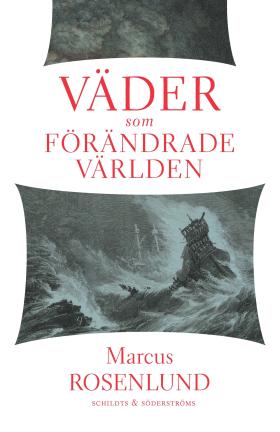
Väder som förändrade världen
(The Weather that Changed the World)
by Marcus Rosenlund
reviewed by Henry Jeppesen
Marcus Rosenlund is a science journalist for Finnish broadcaster YLE. He has been awarded the Topelius Prize for his radio series Kvanthopp (Quantum Leap). Alongside his day job, he has written 3 works of non-fiction, the first of which, Väder som förändrade världen, I am reviewing here. It has won the Finnish State Award for Information Publication and an award from the Society of Swedish Literature in Finland.
Climate change occupies a prominent place in many peoples’ minds these days and for very good reason. In his book, Rosenlund writes about the sometimes destructive, and sometimes benevolent, force of our weather, and its effect on many events throughout history: from prehistoric times up to the present day. Some events that people may be aware of in which weather played a less benevolent role include Julius Caesar’s ill-fated attempt to invade Britain in 55 BC, which was thwarted by stormy weather in the English Channel (he tried again the following year with no joy then either). The Spanish Armada’s attempt to defeat Queen Elizabeth I in 1588 was equally doomed, for similar reasons. And then we have Napoleon at the battle of Waterloo in 1815, where the heavens opened, to put it mildly…
One weather event that Rosenlund writes about is the Little Ice Age, which lasted from around 1300 until 1850. This was the most significant change in our climate since the last ‘official’ Ice Age, more than 11,000 years ago. I feel that this historical period warrants its own paragraph. The substantial drop in temperatures led indirectly to a shortening of the harvest season, crop failures, starvation and a considerable decrease in the population. It also led to revolts, unrest and war. To illustrate the latter, a number of events took place in the very same year (1648): one uprising in Russia, another in France, and civil wars in Ukraine and here in England. Fifty years later, from 1695-97, 150,000 people starved to death in Finland out of a total population of 350,000; a higher percentage even compared to the number who succumbed to the potato famine in Ireland between 1845 and 1849. Speaking of the humble potato, it saved many lives in the 18th century that had been lost in the endless cycle of starvation previously due to crop failures since the 14th century. By the mid-19th century, however, the Little Ice Age was still a factor in the grand scheme of things; in Ireland, farmers had become too dependent on the potato, and in particular, the Irish Lumper, and when the potato crop failed, the eventual outcome was inevitable.
Some of the weather events that have caused the greatest impact on our planet have been volcanic eruptions. The eruption of the Lakagigar craters in Iceland in 1783 lasted for a total of eight months, killing a fifth of the island’s population. An after-effect of this was a volcanic winter, which means a reduction in global temperature caused by droplets of sulphuric acid obscuring the sun and raising Earth’s albedo (the fraction of light its surface reflects) after a large, sulphur-rich, particularly explosive, volcanic eruption. This led to thousands of deaths in other parts of Europe, including Britain. Another super-volcanic eruption, this time at the location of present-day Lake Toba in Sumatra, Indonesia around 75,000 years ago, is said to be one of the most important milestones in the development of modern man and led to our species leaving Africa and starting to explore further afield.
Rosenlund has a wry sense of humour, which helps to raise this book above the level of just a normal academic textbook. He also comes up with nuggets of useful information that could be used to impress friends and acquaintances at dinner parties. For example, did you know that the blood-red sunset in Edvard Munch’s painting The Scream was a nod to the result of the recent eruption of Krakatoa, Indonesia in 1883? As regards climate change, he writes, as we all know, that although time is running out for us to ‘fix’ the issue, he is also positive that we have been here before and are always able to overcome everything our climate has thrown our way. I hope I have whetted your appetite to explore Rosenlund’s journeys further into the interesting world of weather events, as there is much more to discover.

Väder som förändrade världen
Schildts & Söderströms, 2018.
272 pages.
Foreign rights: Helsinki Literary Agency.
Marcus Rosenlund is a science journalist at YLE, the public service broadcaster in Finland. The Weather that Changed the World was his debut book, translated into 9 languages so far.
